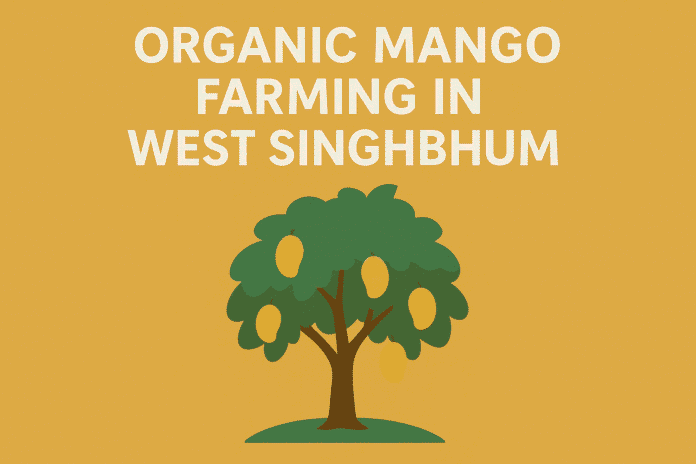Organic Mango Farming in West Singhbhum: A Beginner’s Guide to High-Yield Orchards
Dreaming of lush, chemical-free orchards brimming with sweet fruit? Organic mango farming in West Singhbhum unlocks unparalleled soil benefits and market premiums, yet many beginners struggle with understanding local soils, monsoon patterns, and eco-friendly practices. In this guide, you’ll learn step-by-step how to establish a high-yield organic mango orchard in West Singhbhum—no prior experience required!
Table of Contents
- Why West Singhbhum for Organic Mango Farming?
- Selecting the Right Organic Varieties
- Site Preparation & Soil Management
- Planting Techniques & Orchard Layout
- Irrigation & Rainwater Harvesting
- Organic Nutrient Management & Fertilization
- Pest & Disease Management (IPM)
- Harvesting & Post-Harvest Handling
- Case Study: Iligara Village Success
- Frequently Asked Questions
- Conclusion & Next Steps
1. Why West Singhbhum for Organic Mango Farming?
West Singhbhum’s red loamy soils, rich in iron, coupled with 1,200–1,400 mm of annual rainfall, create perfect conditions for organic mango cultivation. The district’s inclusion in 50 natural farming clusters under the National Mission on Natural Farming underscores its commitment to sustainable horticulture. These clusters span over 2,200 ha, empowering 5,500+ farmers in eco-friendly practices.
- Soil Profile: Excellent drainage reduces root rot risk.
- Climate: Well-timed monsoon supports flowering & fruit set.
- Govt Support: Subsidies via Birsa Harit Gram Yojana for organic inputs.
LSI Keywords: organic mango cultivation, sustainable mango orchards, natural farming mango, West Singhbhum organic farming
2. Selecting the Right Organic Varieties
Cultivar choice is critical for organic systems where chemical controls are restricted. Top picks for West Singhbhum:
- Langra Organic: Early-season, fragrant, resilient to pests.
- Mallika: Sweet, fiberless pulp, ideal for fresh and pulping.
- Amrapali: Dwarf, high-density planting friendly.
- Kesar: Premium fruit with strong consumer demand.
Pro Tip: Always source certified organic grafted saplings (6–8 months old) from accredited nurseries to guarantee authenticity.
3. Site Preparation & Soil Management
- Land Clearing: Remove weeds—don’t burn; compost the biomass.
- Soil Testing: Target pH 5.5–7.0; amend using organic lime if needed.
- Raised Beds: Form ridges (30 cm) to improve aeration in monsoon.
- Organic Matter: Mix 10–15 t/ha of well-rotted farmyard manure (FYM).
Graphic Suggestion: Flowchart illustrating organic site prep steps, from clearing to bed formation.
4. Planting Techniques & Orchard Layout
Optimal spacing maximizes sunlight and airflow in organic systems.
- High-Density: 5 m×5 m (400 trees/ha) with dwarf varieties.
- Traditional: 10 m×10 m (100 trees/ha) for full-size trees.
Planting Steps:
- Dig 60 cm×60 cm×60 cm pits two weeks before planting.
- Line pit with FYM (5 kg) and neem cake (100 g).
- Position sapling at soil level; backfill gently.
- Mulch 15 cm around base to suppress weeds and retain moisture.
LSI Keywords: high-density organic orchards, planting mango saplings organically
5. Irrigation & Rainwater Harvesting
- Drip Irrigation: Reduces water use by up to 40% and limits leaf wetness.
- Rainwater Pits: One pit per 10 trees to capture runoff.
- Schedule: Weekly in dry spells; taper to biweekly post-monsoon.
Infographic Suggestion: Drip system layout with emitters and rainwater pit placement in orchard.
6. Organic Nutrient Management & Fertilization
| Stage | FYM (kg/tree) | Neem Cake (g/tree) | Timing |
|---|---|---|---|
| Planting Year | 10 | 100 | At planting |
| Pre-Flowering | 5 | 50 | One month before |
| Fruit Development | 7 | 70 | During fruit set |
- Micronutrients: Foliar spray of cow urine–ash solution fortnightly.
- Biofertilisers: Azospirillum and Phosphobacteria with FYM.
LSI Keywords: organic fertilizer for mango, biofertilizer in orchards
7. Pest & Disease Management (IPM)
- Weekly monitoring; use yellow sticky traps for mango hoppers.
- Release Trichoderma spp. and Trichogramma wasps as biocontrol.
- Prune overcrowded branches; clear fallen debris.
- Spray 2% neem oil or 5% cow urine decoction when necessary.
Pro Tip: Implement barrier crops (e.g., marigold) around orchards to repel pests.
8. Harvesting & Post-Harvest Handling
- Maturity Sign: Skin shifts to light green-yellow; sap bleeds less.
- Method: Clip fruit with stalk; avoid sap burns.
- Storage: Cool to 12–15 °C; store in ventilated, pesticide-free crates.
Callout: Always wear gloves to prevent sap irritation and maintain hygiene.
9. Case Study: Iligara Village Success
In 2020, Muktamani Sinku in Iligara adopted organic mango farming on 0.5 ha. Intercropping vegetables during initial years generated interim income. By Year 3, yields hit 8 t/ha, netting ₹120,000—50% above local averages. Her organic mangoes now supply premium markets in Ranchi. (source)
10. Frequently Asked Questions
- When will organic mango trees fruit? Grafted trees flower by Year 3; first organic harvest in Year 4.
- Can I intercrop organically? Yes—legumes and short-cycle veggies boost soil nitrogen and income.
- Best organic pesticide? Neem oil (2%) and cow urine–based sprays.
- Managing anthracnose? Improve airflow, remove infected parts, and spray Trichoderma biofungicides.
- Optimal planting time? April–June (pre-monsoon) or September–October (post-monsoon).
11. Conclusion & Next Steps
With the right approach—selecting robust varieties, enriching soil naturally, and leveraging IPM—you can build a sustainable, profitable organic mango orchard in West Singhbhum.
